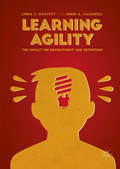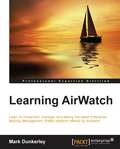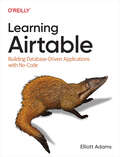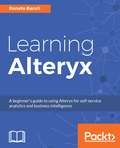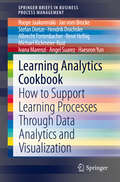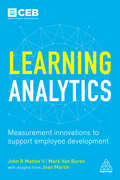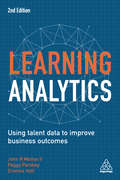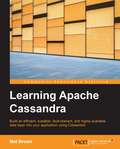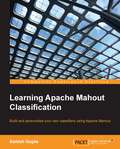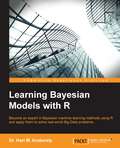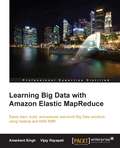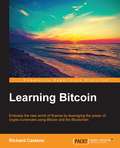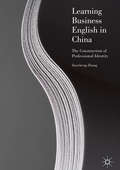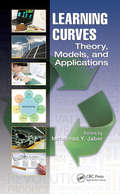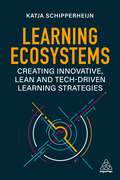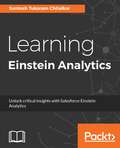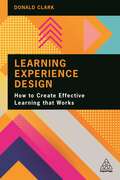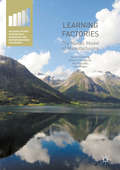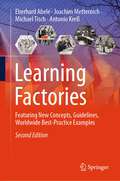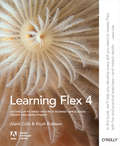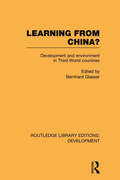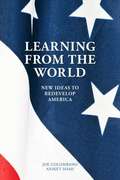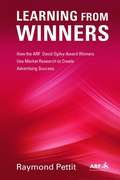- Table View
- List View
Learning Across Products in Biotechnology
by Gary P. PisanoIn this chapter, the author presents a conceptual framework for learning across development projects and examines the approaches of four different biotechnology firms to managing projects and promoting learning of the skills and knowledge most critical to the firm's competitive advantage.
Learning Agile: Understanding Scrum, XP, Lean, and Kanban
by Jennifer Greene Andrew StellmanLearning Agile is a comprehensive guide to the most popular agile methods, written in a light and engaging style that makes it easy for you to learn. Agile has revolutionized the way teams approach software development, but with dozens of agile methodologies to choose from, the decision to "go agile" can be tricky. This practical book helps you sort it out, first by grounding you in agile’s underlying principles, then by describing four specific—and well-used—agile methods: Scrum, extreme programming (XP), Lean, and Kanban.Each method focuses on a different area of development, but they all aim to change your team’s mindset—from individuals who simply follow a plan to a cohesive group that makes decisions together. Whether you’re considering agile for the first time, or trying it again, you’ll learn how to choose a method that best fits your team and your company.Understand the purpose behind agile’s core values and principlesLearn Scrum’s emphasis on project management, self-organization, and collective commitmentFocus on software design and architecture with XP practices such as test-first and pair programmingUse Lean thinking to empower your team, eliminate waste, and deliver software fastLearn how Kanban’s practices help you deliver great software by managing flowAdopt agile practices and principles with an agile coach
Learning Agility
by Linda S. Gravett Sheri A. CaldwellThis book concretely defines the concept of learning agility and offers a business case for why organizations of all types should concentrate on building and sustaining this approach. It provides readers with a holistic approach towards the topic, and helps leaders leverage the learning agility of individual employees to sustain a learning-agile workplace culture. Synthesizing academic research and practical approaches, this book takes leaders through ways to interview and assess potential employees for learning agility, develop and foster an environment for learning agility, and measure the results of a learning agile workplace. The authors present an innovative learning agility assessment which has been developed, tested, and implemented by clients and outline metrics which can measure the results of a learning agile workforce. This little-understood but highly advantageous approach is crucial for leaders to understand if they wish to deliver results and impact their organizations' bottom line.
Learning AirWatch
by Mark DunkerleyIf you are a technical professional who wants to dive deeper into the functionality offered by AirWatch or manage the solution, then this book will help you choose the best set of configuration, device management, and monitoring options that you can use to effectively manage your EMM implementation.
Learning Airtable: Building Database-Driven Applications with No-Code
by Elliott AdamsGet a concise yet comprehensive overview of Airtable, one of the most versatile platforms to emerge from the no-code movement. Whether you're planning a new project, sharing data analysis within your organization, tracking a detailed initiative among stakeholders, or dealing with any other project that requires well-structured collaboration, this practical book shows you how Airtable is an accessible tool to tackle these challenges.Author Elliott Adams guides you through the process of structuring your data in a relational database, creating automations based on changes to data in Airtable, and building user-friendly interfaces for no-code applications. This showcases how Airtable is superior to the typical options of either non-developers using spreadsheets or making large investments in time-consuming application development.With this book, you will:Learn how Airtable can reduce the need for custom-built applicationsUse Airtable to replace internal tools such as spreadsheetsBuild applications utilizing relational data--without any knowledge of software programmingEvaluate whether you can build a solution on Airtable rather than purchasing softwareUnderstand the limitations of the Airtable platform when compared with writing a software application from scratch
Learning Alteryx: A beginner's guide to using Alteryx for self-service analytics and business intelligence
by Alok Khobragade Mayur Ravindra Narkhede Renato BarutiKey Features Experience the power of codeless analytics using Alteryx, a leading Business Intelligence tool Uncover hidden trends and valuable insights from your data across different sources and make accurate predictions Includes real-world examples to put your understanding of the features in Alteryx to practical use Book Description Alteryx, as a leading data blending and advanced data analytics platform, has taken self-service data analytics to the next level. Companies worldwide often find themselves struggling to prepare and blend massive datasets that are time-consuming for analysts. Alteryx solves these problems with a repeatable workflow designed to quickly clean, prepare, blend, and join your data in a seamless manner. This book will set you on a self-service data analytics journey that will help you create efficient workflows using Alteryx, without any coding involved. It will empower you and your organization to take well-informed decisions with the help of deeper business insights from the data.Starting with the fundamentals of using Alteryx such as data preparation and blending, you will delve into the more advanced concepts such as performing predictive analytics. You will also learn how to use Alteryx’s features to share the insights gained with the relevant decision makers. To ensure consistency, we will be using data from the Healthcare domain throughout this book. The knowledge you gain from this book will guide you to solve real-life problems related to Business Intelligence confidently. Whether you are a novice with Alteryx or an experienced data analyst keen to explore Alteryx’s self-service analytics features, this book will be the perfect companion for you. What you will learn Create efficient workflows with Alteryx to answer complex business questions Learn how to speed up the cleansing, data preparing, and shaping process Blend and join data into a single dataset for self-service analysis Write advanced expressions in Alteryx leading to an optimal workflow for efficient processing of huge data Develop high-quality, data-driven reports to improve consistency in reporting and analysis Explore the flexibility of macros by automating analytic processes Apply predictive analytics from spatial, demographic, and behavioral analysis and quickly publish, schedule Share your workflows and insights with relevant stakeholders
Learning Analytics Cookbook: How to Support Learning Processes Through Data Analytics and Visualization (SpringerBriefs in Business Process Management)
by Hendrik Drachsler Michael Kickmeier-Rust Stefan Dietze Ivana Marenzi Jan vom Brocke Roope Jaakonmäki Albrecht Fortenbacher René Helbig Angel Suarez Haeseon YunThis book offers an introduction and hands-on examples that demonstrate how Learning Analytics (LA) can be used to enhance digital learning, teaching and training at various levels. While the majority of existing literature on the subject focuses on its application at large corporations, this book develops and showcases approaches that bring LA closer to smaller organizations, and to educational institutions that lack sufficient resources to implement a full-fledged LA infrastructure. In closing, the book introduces a set of software tools for data analytics and visualization, and explains how they can be employed in several LA scenarios.
Learning Analytics: Measurement Innovations to Support Employee Development
by Jean Martin Mark Van Buren John MattoxFaced with organizations that are more dispersed, a workforce that is more diverse and the pressure to reduce costs, CEOs and CFOs are increasingly asking what the return on investment is from training and development programmes. Learning Analytics provides a framework for understanding how to work with learning analytics at an advanced level. It focuses on the questions that training evaluation is intended to answer: is training effective and how can it be improved? It discusses the field of learning analytics, outlining how and why analytics can be useful, and takes the reader through examples of approaches to answering these questions and looks at the valuable role that technology has to play. Even where technological solutions are employed, the HR or learning and development practitioner needs to understand what questions they should be asking of their data to ensure alignment between training and business needs.Learning Analytics enables both senior L&D and HR professionals as well as CEOs and CFOs to see the transformational power that effective analytics has for building a learning organization, and the impacts that this has on performance, talent management, and competitive advantage. It helps learning and development professionals to make the business case for their activities, demonstrating what is truly adding value and where budgets should be spent, and to deliver a credible service to their business by providing metrics based on which sound business decisions can be made.
Learning Analytics: Using Talent Data to Improve Business Outcomes
by Cristina Hall John R Mattox II Peggy ParskeyEffective evaluation and measurement of learning and development initiatives is critical to maximise the impact of training, identify gaps for improvement and ensure that efforts are aligned to the business' needs. Learning Analytics outlines how analytical approaches can respond to these challenges, the types and benefits of technological solutions and how to ask the right questions of organizational data in order to build a learning organization that boosts performance and competitive advantage.Drawing upon case studies from organizations who have applied such approaches such as The Gap, Hilton Worldwide University and Seagate Technology, Learning Analytics will enable those involved in learning and development to make the business case for their activities and deliver an evidence-based service to their organizations. Alongside updated chapters on learning technology tools and moving beyond learning analytics to talent management analytics, this second edition also features new content on measuring informal learning, increasing data literacy, and framing L&D's contributions through a portfolio evaluation approach.
Learning Apache Cassandra
by Mat BrownIf you're an application developer familiar with SQL databases such as MySQL or Postgres, and you want to explore distributed databases such as Cassandra, this is the perfect guide for you. Even if you've never worked with a distributed database before, Cassandra's intuitive programming interface coupled with the step-by-step examples in this book will have you building highly scalable persistence layers for your applications in no time.
Learning Apache Mahout Classification
by Ashish GuptaIf you are a data scientist who has some experience with the Hadoop ecosystem and machine learning methods and want to try out classification on large datasets using Mahout, this book is ideal for you. Knowledge of Java is essential.
Learning Bayesian Models with R
by Dr Hari M. KoduvelyThis book is for statisticians, analysts, and data scientists who want to build a Bayes-based system with R and implement it in their day-to-day models and projects. It is mainly intended for Data Scientists and Software Engineers who are involved in the development of Advanced Analytics applications. To understand this book, it would be useful if you have basic knowledge of probability theory and analytics and some familiarity with the programming language R.
Learning Big Data with Amazon Elastic MapReduce
by Amarkant Singh Vijay RayapatiThis book is aimed at developers and system administrators who want to learn about Big Data analysis using Amazon Elastic MapReduce. Basic Java programming knowledge is required. You should be comfortable with using command-line tools. Prior knowledge of AWS, API, and CLI tools is not assumed. Also, no exposure to Hadoop and MapReduce is expected.
Learning Bitcoin
by Richard CaetanoEmbrace the new world of fiance by leveraging the power of crypto-currencies using Bitcoin and the BlockchainAbout This BookSet up your own wallet, buy and sell Bitcoin, and execute custom transactions on the BlockchainLeverage the power of Bitcoin to reduce transaction costs and eliminate fraudA practical step-by-step guide to break down the Bitcoin technology to ensure safe transactionsWho This Book Is ForIf you are familiar with online banking and want to expand your finances into a resilient and transparent currency, this book is ideal for you. A basic understanding of online wallets and financial systems will be highly beneficial to unravel the mysteries of Bitcoin.What You Will LearnSet up your wallet and buy a Bitcoin in a flash while understanding the basics of addresses and transactionsAcquire the knack of buying, selling, and trading Bitcoins with online marketplacesSecure and protect your Bitcoins from online theft using Brainwallets and cold storageUnderstand how Bitcoin's underlying technology, the Blockchain, works with simple illustrations and explanationsConfigure your own Bitcoin node and execute common operations on the networkDiscover various aspects of mining Bitcoin and how to set up your own mining rigDive deeper into Bitcoin and write scripts and multi-signature transactions on the networkExplore the various alt-coins and get to know how to compare them and their valueIn DetailThe financial crisis of 2008 raised attention to the need for transparency and accountability in the financial world. As banks and governments were scrambling to stay solvent while seeking a sustainable plan, a powerfully new and resilient technology emerged.Bitcoin, built on a fundamentally new technology called "The Blockchain," offered the promise of a new financial system where transactions are sent directly between two parties without the need for central control.Bitcoin exists as an open and transparent financial system without banks, governments, or corporate support. Simply put, Bitcoin is "programmable money" that has the potential to change the world on the same scale as the Internet itself.This book arms you with immense knowledge of Bitcoin and helps you implement the technology in your money matters, enabling secure transactions.We first walk through the fundamentals of Bitcoin, illustrate how the technology works, and exemplify how to interact with this powerful and new financial technology. You will learn how to set up your online Bitcoin wallet, indulge in buying and selling of bitcoins, and manage their storage. We then get to grips with the most powerful algorithm of all times: the Blockchain, and learn how crypto-currencies can reduce the risk of fraud for e-commerce merchants and consumers.With a solid base of Blockchain, you will write and execute your own custom transactions. Most importantly, you will be able to protect and secure your Bitcoin with the help of effective solutions provided in the book. Packed with plenty of screenshots, Learning Bitcoin is a simple and painless guide to working with Bitcoin.Style and approachThis is an easy-to-follow guide to working with Bitcoin and the Blockchain technology. This book is ideal for anyone who wants to learn the basics of Bitcoin and explore how to set up their own transactions.
Learning Business English in China
by Zuocheng ZhangThis book analyses the learning experiences of students of Business English at a Chinese university. It addresses several topical issues in English for Specific Purposes (ESP) education and Business English teaching, including how ESP students learn, how they develop multiple identities. In particular, it focuses on their professional identity in the classroom, and how these identities are transferred to the workplace. This allows the author to present a model of learning Business English that corresponds to the lived experiences of students in China, but which can also be applied to other ESP learner contexts. In doing so, he demonstrates how to research the professional identity of ESP learners from multiple perspectives, and contributes to the validity of research on language learning and learner identity. This book will appeal to scholars of English for Specific Purposes, Second Language Acquisition, and TESOL Education.
Learning Curves: Theory, Models, and Applications (Systems Innovation Book Series)
by Mohamad Y. JaberWritten by international contributors, Learning Curves: Theory, Models, and Applications first draws a learning map that shows where learning is involved within organizations, then examines how it can be sustained, perfected, and accelerated. The book reviews empirical findings in the literature in terms of different sources for learning and partia
Learning Ecosystems: Creating Innovative, Lean and Tech-driven Learning Strategies
by Katja SchipperheijnBuilding and sustaining an organization which is nimble, adaptable, resilient and future proof is both complex and urgent. Only those with flexible and innovative Learnscapes will succeed.Learning Ecosystems explains how organizations evolve into LearnScapes where learning techniques are aligned with continuous interaction with the ecosystem they are part of. It explains how to upskill and reskill a workforce continuously in an increasingly collaborative and tech-enabled world. Full of practical guidance and strategic advice, this book covers how to take a lifelong approach to learning in the organization and the core competencies needed for this. It explains what to do when building a value and data-driven learning strategy and discusses the symbiosis of people and technology. This book explores lean learning, data analytics, learning technologies including artificial intelligence (AI) and the ethics of using these technologies. There is also crucial guidance on how to take a human-centric approach to innovation. Learning Ecosystems demonstrates the value of continuous improvement and offers techniques for a variety of situations including problem analyses, experimentation and algorithmic business thinking. Most importantly, it provides guidance on how to build a learning culture and a learning ecosystem throughout the company. Supported by case studies from companies including Etihad Airways, ING, ESF and FEDEX, this is essential reading from a leading learning innovator who has helped global organizations to rethink their learning strategies to achieve sustained business growth.
Learning Einstein Analytics: Unlock critical insights with Salesforce Einstein Analytics
by Santosh ChitalkarLearn to confidently setup and create app, lenses, dashboards using Salesforce Einstein Analytics. Key Features Explore Einstein analytics on desktop as well as mobile platforms Turn data into smarter sales with Einstein Analytics for Sales Visualize your data with preloaded as well as customized dashboards Book Description Salesforce Einstein analytics aka Wave Analytics is a cloud-based platform which connects data from the multiple sources and explores it to uncover insights. It empowers sales reps, marketers, and analysts with the insights to make customer interactions smarter, without building mathematical models. You will learn to create app, lenses, dashboards and share dashboards with other users. This book starts off with explaining you fundamental concepts like lenses, step, measures and sets you up with Einstein Analytics platform. We then move on to creating an app and here you will learn to create datasets, dashboards and different ways to import data into Analytics. Moving on we look at Einstein for sales, services, and marketing individually. Here you will learn to manage your pipeline, understand important business drivers and visualize trends. You will also learn features related to data monitoring tools and embedding dashboards with lightning, visualforce page and mobile devices. Further, you will learn advanced features pertaining to recent advancements in Einstein which include machine learning constructs and getting predictions for events. By the end of this book, you will become proficient in the Einstein analytics, getting insights faster and understanding your customer in a better way. What you will learn - Create app, lenses, and dashboards using Einstein. - Visualize data utilizing all the widgets available with Einstein. - Understand Einstein for Sales, Service, and Marketing separately. - Use Data monitoring tools to monitor data flow and system jobs. - Abstract machine learning constructs and make predictions on events Who this book is for This book is for data scientists, business users, developers who want to explore business data using the Salesforce Einstein Analytics. Knowledge of the Salesforce platform is required.
Learning Experience Design: How to Create Effective Learning that Works
by Donald ClarkHow can I create in-person learning that engages people? How can I build digital learning that is effective? How can I develop learning content that can be used remotely and ensure that the learning sticks? Learning Experience Design has the answers to all these questions and more. This book is a practical guide for all learning and development (L&D) professionals. It covers everything from what learning experience design (LXD) is, the role of the L&D professional in LXD, and what the main areas to consider when designing learning are including emotion, attention, memory, engagement, enjoyment, transfer, practice and learning retention. It includes practical advice for all areas of learning design including text, graphics, audio, visual, simulations, AR/VR, question and social design. There is also essential guidance on instructional design, UX (user experience) design and how to design effective learning analytics. The final part of the book covers design thinking, blended learning and discussion of LMSs (learning management systems), LXPs (learning experience platforms) and LRSs (learning record stores). With examples, tips, case studies and advice throughout, this is an invaluable book for anyone wanting to make an impact with their learning design and ensure knowledge, skills and performance improvement.
Learning Factories
by Elias G. Carayannis Halvor Holtskog Aris Kaloudis Geir RingenThis book examines how the norms, culture, and practices of the socio-economic Nordic model give them a competitive edge in globalized production chains. Using the Norwegian automotive industry - one of the most globalized industries in the world - as the empirical foundation of the book, it examines the strengths, tensions, and challenges the Norwegian work organization style meets in this particular business environment. The Nordic countries (made up of Norway, Denmark, Finland, Iceland, and Sweden) have made remarkable progress through a combination of flexible labor markets, income security, a democratic approach to work, and the ability to adapt and learn at the local level. This book explores the current indicators of competitiveness, innovation, scientific excellence, and well-being as compared with the US, UK, EU, Japan, and elsewhere to address the hotly debated question of how institutions and culture contribute to or inhibit certain forms of work organization, learning, and economic performance. Integrating action research, organization studies, and learning and innovation economics, this book provides a more precise understanding of how institutions and cultures at a macro level shape learning practices in a competitive industry.
Learning Factories: Featuring New Concepts, Guidelines, Worldwide Best-Practice Examples
by Eberhard Abele Joachim Metternich Michael Tisch Antonio KreßThis book presents the state of the art of learning factories. It outlines the motivations, historic background, and the didactic foundations of learning factories. Definitions of the term learning factory and an updated morphological model are provided as well as a detailed overview of existing learning factory approaches in industry and academia, showing the broad range of different applications and varying contents in all continents. International learning factory best-practice examples are presented in detailed and structured manner. The state of the art of learning factories curricula design and their use to enhance learning and research as well as potentials and limitations are presented. Further research priorities and innovative learning factory concepts to overcome current barriers are offered. While today numerous learning factories have been built in industry (big automotive companies, pharma companies, etc.) and academia in the last decades, a comprehensive handbook for the scientific community and practitioners alike is still missing. The book addresses therefore both researchers in production-related areas that want to conduct industry-relevant research and education, as well as managers and engineers in industry, who are searching for an effective way to train their employees. In addition to this, the learning factory concept is also regarded as an innovative learning concept in the field of didactics.
Learning Flex 4: Getting Up to Speed with Rich Internet Application Design and Development (Adobe Developer Library)
by Alaric Cole Elijah RobisonLearn Adobe Flex 4 in a fun and engaging way with this book's unique, hands-on approach. Using clear examples and step-by-step coaching from two experts, you'll create four applications that demonstrate fundamental Flex programming concepts. Throughout the course of this book, you'll learn how to enhance user interaction with ActionScript, and create and skin a user interface with Flex's UI components (MXML) and Adobe's new FXG graphics format. You'll also be trained to manage dynamic data, connect to a database using server-side script, and deploy applications to both the Web and the desktop. Learning Flex 4 offers tips and tricks the authors have collected from years of real-world experience, and straightforward explanations of object-oriented programming concepts to help you understand how Flex 4 works. Work with Flash Builder 4 and the Eclipse IDE Learn the basics of ActionScript, MXML, and FXG Design a Flex application layout Build an engaging user interface Add interactivity with ActionScript Handle user input with rich forms Link Flex to a server with PHP and MySQL Gather and display data Style applications and add effects, filters, and transitions Deploy applications to the Web, or to the desktop using Adobe AIR
Learning From China?: Development and Environment in Third World Countries (Routledge Library Editions: Development)
by Bernhard GlaeserFirst published in 1987, this volume was written to shed some light upon the nature and environmental consequences and wider relevance of development strategies in the Peoples’ Republic of China. It covers industrialisation, food production, energy use and landscape and settlement planning. The Chinese "autocentred" strategy is assessed from both the developmental and the environmental viewpoints. Decision-making processes and the opportunities to implement environmental policy in other parts of the developing world are analysed and the volume concludes with the view that benefits to other countries are likely to arise out of increased co-operation and exchange with China, although the Chinese model is by no means a panacea. All students and researchers interested in either environmental or developmental issues will find this book to be a substantial and enlightening contribution to literature.
Learning From The World
by Joe Colombano Aniket ShahWhat can America learn from countries as faraway and diverse as Bhutan, Chile, Denmark, Nigeria and South Korea? Quite a lot, as it turns out. At a time of fundamental change in global power, the country that undisputedly ruled the latter half of the 20th century is no longer firmly in the lead. In the search for new ideas to redevelop America, co-editors Joe Colombano and Aniket Shah point to what has happened outside the borders of the United States. By relying on a wealth of cross-country and multi-disciplinary contributions from an impressive number of world-renown experts, the editors provide a systematic review of successful policies undertaken overseas, discuss their relevance to the US, and offer them as contributions to the national debate on the future of the American economy. What they find is a rich set of policy recipes - from maintaining fiscal discipline and fostering growth, to reviving competitiveness to ensuring equity and basic human decency.
Learning From Winners: How the ARF Ogilvy Award Winners Use Market Research to Create Advertising Success
by Raymond PettitThis book demonstrates how the best companies use the creative application of research, done up front, to produce the big ideas with significant impact on the market and on the people, employees, partners, retailers and customers. Readers of this book will experience how brand managers and their agencies use the right research to drive new brand in


